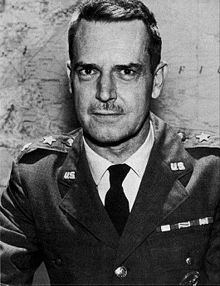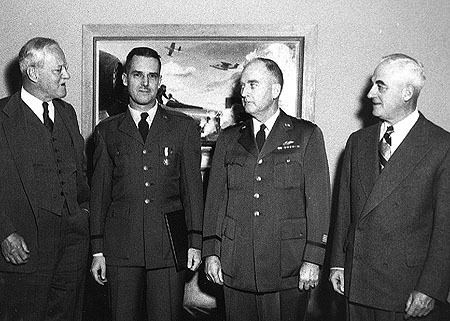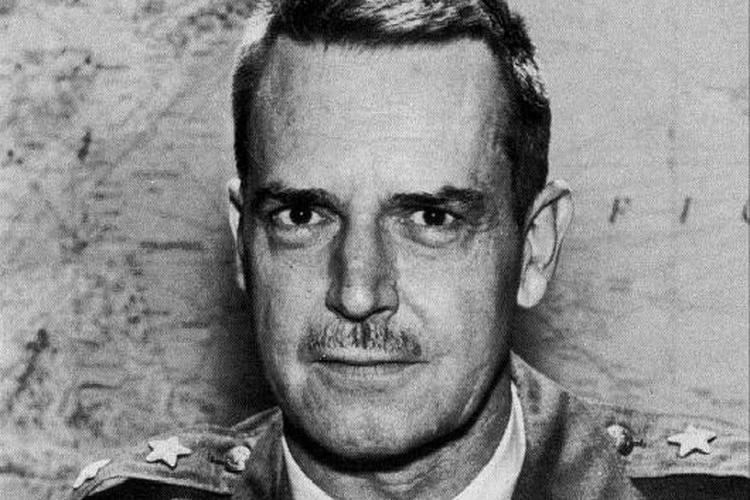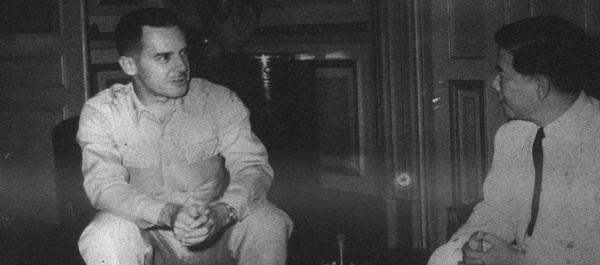Birth name Edward Geary Lansdale Name Edward Lansdale | Years of service 1943-1963 Books In the midst of wars | |
 | ||
Battles/wars World War IIVietnam War Spouse(s) Helen Batcheller (m. 1933-1972)Patrocinio Yapcinco (m. 1973-1987) Died February 23, 1987, McLean, Dranesville, Virginia, United States Awards Distinguished Service Medal, National Security Medal, Philippine Legion of Honor, Military Merit Medal | ||
Allegiance United States of America | ||
Jfk edward lansdale
Edward Geary Lansdale (February 6, 1908 – February 23, 1987) was a United States Air Force officer who served in the Office of Strategic Services and the Central Intelligence Agency (CIA). He rose to the rank of Major General and was awarded the Distinguished Service Medal in 1963. He was an early proponent of more aggressive U.S. actions in the Cold War. Lansdale was born in Detroit, Michigan and died in McLean, Virginia. He is buried in Arlington National Cemetery. He was twice married and had two sons from his first marriage.
Contents
- Jfk edward lansdale
- Edward lansdale on saigon mission 1954 1957 preview
- Early life
- World War II
- Philippines
- Vietnam
- Anti Castro campaign
- Late in his career
- Portrayal in Oliver Stones JFK
- References

Edward lansdale on saigon mission 1954 1957 preview
Early life

Lansdale was born in Detroit, Michigan on February 6, 1908. He was the second of the four sons of Sarah Frances Philips of California and Henry Lansdale of Virginia. Lansdale attended school in Michigan, New York and California before attending UCLA where he earned his way largely by writing for newspapers and magazines. He moved on to better paying work in advertising in Los Angeles and San Francisco.
World War II

In World War II, he served with the Office of Strategic Services and in 1943 he was commissioned as a lieutenant in the U.S. Army, working various military intelligence assignments throughout the war. In 1945 after several wartime promotions, he was transferred to Headquarters Air Forces Western Pacific as a major, where he became chief of the Intelligence Division.
Philippines

Lansdale extended his tour to remain in the Philippines until 1948, helping the Philippine Army rebuild its intelligence services and resolve the cases of large numbers of prisoners of war. Lansdale was commissioned as a captain in the United States Air Force in 1947, with the temporary rank of major. After leaving the Philippines in 1948, he served as an instructor at the Strategic Intelligence School, Lowry Air Force Base, Colorado, where he received a temporary promotion to lieutenant colonel in 1949. In 1950, President Elpidio Quirino personally requested that Lansdale be transferred to the Joint United States Military Assistance Group, Philippines, to assist the intelligence services of the Armed Forces of the Philippines combat the Communist Hukbalahap. Ramon Magsaysay had just been appointed secretary of national defense and Lansdale was made liaison officer to him. The two men became close friends, frequently visiting the combat areas together. With Lansdale's help, Magsaysay eventually became President of the Philippines on December 30, 1953. Lansdale helped the Philippine Armed Forces develop psychological operations, civic actions, and the rehabilitation of Hukbalahap prisoners in projects such as EDCOR. He was temporarily promoted to colonel in 1951.
Vietnam
Lansdale was a member of General John W. O'Daniel's mission to Indo-China in 1953, acting as an advisor on special counter-guerrilla operations to French forces against the Viet Minh. From 1954-57 he was stationed in Saigon as the head of the Saigon Military Mission (SMM). During this period he was active in the training of the Vietnamese National Army (VNA), organizing the Caodaist militias under Trình Minh Thế in an attempt to bolster the VNA, a propaganda campaign encouraging Vietnam's Catholics to move to the south as part of Operation Passage to Freedom, and spreading claims that North Vietnamese agents were making attacks in South Vietnam. Before the widely discredited 1955 referendum that saw Prime Minister Ngô Đình Diệm depose head of state Bảo Đại and proclaim himself President of the newly formed Republic of Vietnam, Lansdale advised Diệm, with whom had a close friendship, to not rig the poll and to be content with a realistic 60-70% result, advice Diệm did not take. Diệm was credited with 98.2% of the vote overall and 133% in Saigon.
Lansdale mentored and trained Phạm Xuân Ẩn, a reporter for Time magazine who was actually a highly placed North Vietnamese spy. In 1961, he helped to publicize the story of Father Nguyen Lac Hoa, the "fighting priest" who had organized a crack militia called the Sea Swallows from his village of anti-communist Chinese Catholic exiles. In 1961, Lansdale recruited John M. Deutch to his first job in government, working as one of Robert McNamara's 'Whiz Kids'. Deutch would go on to be the 17th Director of Central Intelligence.
Anti-Castro campaign
From 1957 to 1963 Lansdale worked for the Department of Defense in Washington, serving as Deputy Assistant Secretary for Special Operations, Staff Member of the President's Committee on Military Assistance, and Assistant Secretary of Defense for Special Operations. During the early 1960s he was chiefly involved in clandestine efforts to topple the government of Cuba, including proposals to assassinate Fidel Castro. Much of this work was under the aegis of "Operation Mongoose", which was the operational name for the CIA plan to topple Castro's government. According to Daniel Ellsberg, who was at one time a subordinate to Lansdale, Lansdale claimed that he was fired by President Kennedy's Defense Secretary Robert McNamara after he declined Kennedy's offer to play a role in the overthrow of the Diem regime.
Late in his career
He retired from the Air Force on November 1, 1963. Yet from 1965 to 1968 he was back in Vietnam where he worked in the United States Embassy, Saigon, with the rank of minister. The scope of his delegated authority was vague, however, and he was bureaucratically marginalized and frustrated. His 1972 memoir, In the Midst of Wars. An American's Mission to Southeast Asia, covers his time in the Philippines and Vietnam up to December, 1956.
His biography, The Unquiet American, was written by Cecil Currey and published in 1988; the title refers to the common, but incorrect belief, that the eponymous character in Graham Greene's novel The Quiet American was based on Lansdale. According to Norman Sherry's authorized biography of Greene The Life of Graham Greene (Penguin, 2004), Lansdale did not officially enter the Vietnam arena until 1954, while Greene wrote his book in 1952 after departing Vietnam. More likely is that he was the inspiration for the character Colonel Hillandale in Eugene Burdick's and William Lederer's joint novel The Ugly American published in 1958. Many of Lansdale's private papers and effects were destroyed in a fire at his McLean home in 1972. In 1981, Lansdale donated most of his remaining papers to Stanford University's Hoover Institution.
Lansdale died of a heart ailment on February 23, 1987.
Portrayal in Oliver Stone's JFK
L. Fletcher Prouty alleged that Lansdale can be seen in one of the "three tramps" photographs that were taken near the Texas School Book Depository shortly after the assassination of United States President John F. Kennedy. Based on Prouty's account of Lansdale, Dale Dye portrayed the character named "General Y" in the 1991 Oliver Stone film JFK. According to Stone, the development of the character was inspired by Prouty. He said that it was not meant to be Lansdale, but rather someone "like a Lansdale" that represented alleged misdeeds on the part of the CIA in a cover-up of the assassination.
